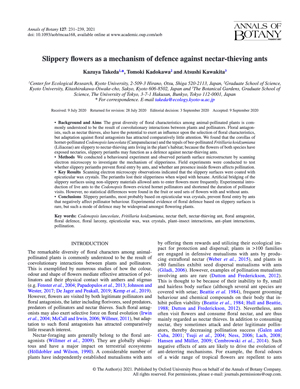NEWS 2021
Slippery flowers as a mechanism of defence against nectar-thieving ants
Kazuya TAKEDA1, Tomoki KADOKAWA2, Atsushi KAWAKITA1,2
Annals of Botany 127:231–239 (2021)
https://academic.oup.com/aob/article/127/2/231/6067337
1Center for Ecological Research, Kyoto University, 2-509-3 Hirano, Otsu, Shiga 520-2113, Japan2
Graduate School of Science, Kyoto University, Kitashirakawa-Oiwake-cho, Sakyo, Kyoto 606-8502, Japan3
The Botanical Gardens, Graduate School of Science, The University of Tokyo, 3-7-1 Hakusan, Bunkyo, Tokyo 112-0001, Japan
Abstract
Background and Aims The great diversity of floral characteristics among animal-pollinated plants is com-monly understood to be the result of coevolutionary interactions between plants and pollinators. Floral antagon-ists, such as nectar thieves, also have the potential to exert an influence upon the selection of floral characteristics, but adaptation against floral antagonists has attracted comparatively little attention. We found that the corollas of hornet-pollinated Codonopsis lanceolata (Campanulaceae) and the tepals of bee-pollinated Fritillaria koidzumiana (Liliaceae) are slippery to nectar-thieving ants living in the plant’s habitat; because the flowers of both species have exposed nectaries, slippery perianths may function as a defence against nectar-thieving ants.
Methods We conducted a behavioural experiment and observed perianth surface microstructure by scanning electron microscopy to investigate the mechanism of slipperiness. Field experiments were conducted to test whether slippery perianths prevent floral entry by ants, and whether ant presence inside flowers affects pollination.
Key Results Scanning electron microscopy observations indicated that the slippery surfaces were coated with epicuticular wax crystals. The perianths lost their slipperiness when wiped with hexane. Artificial bridging of the slippery surfaces using non-slippery materials allowed ants to enter flowers more frequently. Experimental intro-duction of live ants to the Codonopsis flowers evicted hornet pollinators and shortened the duration of pollinator visits. However, no statistical differences were found in the fruit or seed sets of flowers with and without ants.
Conclusions Slippery perianths, most probably based on epicuticular wax crystals, prevent floral entry by ants that negatively affect pollinator behaviour. Experimental evidence of floral defence based on slippery surfaces is rare, but such a mode of defence may be widespread amongst flowering plants.




